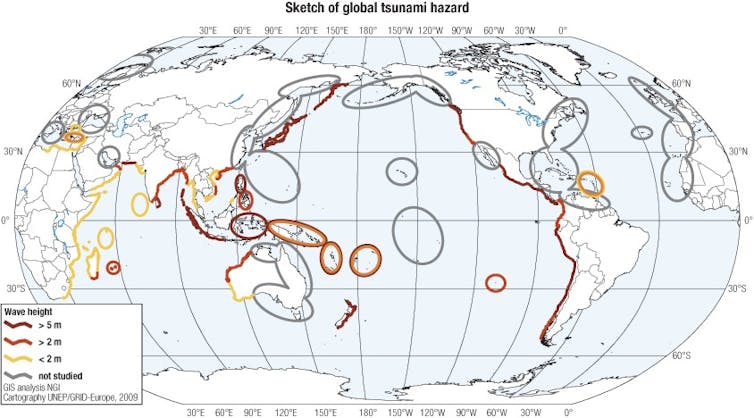
Four steps tsunami-prone nations must do to get ready for the next tragedy
One of the most severe natural disasters in recent memory was the tsunami that followed the eruption of an undersea volcano that struck Tonga on January 16. Despite the disastrous effects of this catastrophe, similar occurrences are rather typical because volcanoes are globally distributed, intrinsically unstable, and unpredictable.
I've spent the most of my career conducting post-disaster field research, enhancing coastal fortifications, and helping people become less fearful of the risk and more tsunami-resilient. Countries in these naturally susceptible regions of the world face the task of adapting and educating their citizens to adopt their own safety precautions.
Global tsunami risk diagram (as of May 2009). UN Office for the Reduction of Disaster Risk
1. Teach people to be more tenacious.
One of the most powerful defenses is education. No matter how big the wave is or how strong the seawalls are, people are considerably more likely to escape a tsunami if they know exactly what to do when the signal goes off. Therefore, it is imperative for vulnerable nations to forge an informed, close-knit society that recognizes the risk they face and accepts it as a part of their way of life.
Transparent, based on research, written by professionals, and always free.
After the 2018 Anak Krakatoa tsunami, I held focus group discussions with individuals, businesses, and communities throughout Indonesia. We built designated high ground locations in these groupings, with obvious signage pointing people in the right direction. It is important to periodically conduct evacuation drills, such as mock tsunami drills, so that people are familiar with safe regions and know where to evacuate in the case of a genuine tsunami.
Tsunami safety must be covered in both elementary and secondary education in Tonga, where a third of the population is under the age of 15. They will become more resilient if they educate their young people about tsunamis and other natural disasters like cyclones and earthquakes.
A tsunami detection buoy off the coast of Thailand. The Mariner 4291 / Shutterstock
When water levels are triggered, tsunami alert messages are sent out, giving people enough time to escape the impact zones. I experienced this myself while conducting fieldwork in a small town on the southern coast of Japan in 2018. There was an earthquake during my stay and before the ground had even stopped shaking my colleague received a text alert from the regional government with instructions. I grabbed my passport and prepared to go towards a nearby hill if he received a follow-up “red alert” text – fortunately, that particular earthquake did not cause a tsunami, and we were able to stay where we were.
2. Establish reliable early warning systems
A tsunami is imminent when ocean surface levels drop, which provides obvious warning. In order to detect tsunamis before they occur, vulnerable nations must develop early warning systems that use satellites, drones, and tidal gauges to measure the vertical rise or fall of water.
It would also be beneficial to position tools like conductivity-temperature-depth (CTD) devices, seismometers, and thermal cameras close to underwater volcanoes while simultaneously keeping an eye on the sea above with satellites in light of the tsunami that hit Tonga. In the open ocean, buoys that gauge wave height and direction can also be positioned.
A new coastal dyke in the city of Sendai, Japan, built after the 2011 tsunami. Ravindra Jayaratne, Author provided
Critical infrastructure like power plants, densely populated communities and tourist hotspots must be built on higher ground, where possible. A good example of this comes from Miyagi and Iwate prefectures, Japan, which were badly hit by the 2011 Tohoku tsunami (the one which caused a nuclear disaster in neighboring Fukushima). Some towns were rebuilt on elevated ground that had been filled in with compacted soil.
If space is available, coastal forests with tall trees could be planted between communities and the beach to act as a buffer zone, limiting the impact of waves and reducing flooding, while also improving the local ecosystem.
These defenses may damage the tourist-friendly aesthetic of white sandy beaches, but they could save lives.
3. Create a robust coastline defense strategy.
The construction of offshore breakwaters, tsunami walls, and flood levees is urgently required in tsunami-prone countries. These foundations should preferably be constructed of reinforced concrete to prevent erosion due to the force of tsunami waves. Natural defenses like coral reefs might be enhanced using naturally occurring materials like heavy sandbags or rock armor, which would be less expensive for developing nations.
4. Create a regional tsunami response strategy.
Australia, New Zealand, Japan, and America all suffered the consequences of the Tonga tsunami and underwater volcanic eruption. The defense and response to tsunamis must be regionally coordinated in these susceptible nations.
Not only after a tsunami strikes, but also before. Sharing information, knowledge, research facilities, and equipment can help with this. It is crucial that emerging nations explicitly receive this knowledge in order to bolster their own defenses.
The eruption sent debris 40 kilometers into the skies and brought about tsunamis all over the Pacific. Alamy and ZUMA Press, Inc.
The subaquatic volcano close to Tonga is erupting. Furthermore, even if the most recent eruption was a once in 1,000-year occurrence, there is still a good probability that it will occur again because geological deposits indicate that large eruptions like this one frequently entail a string of smaller explosive occurrences.
Tsunami-prone nations can't stop these calamities from happening, but they can make adjustments to improve their preparedness for when they do. Tonga will need outside assistance to recover from this terrible catastrophe. On the other hand, in the long run, teamwork and education will be its most significant defense.






 Sound Seismic
Sound Seismic